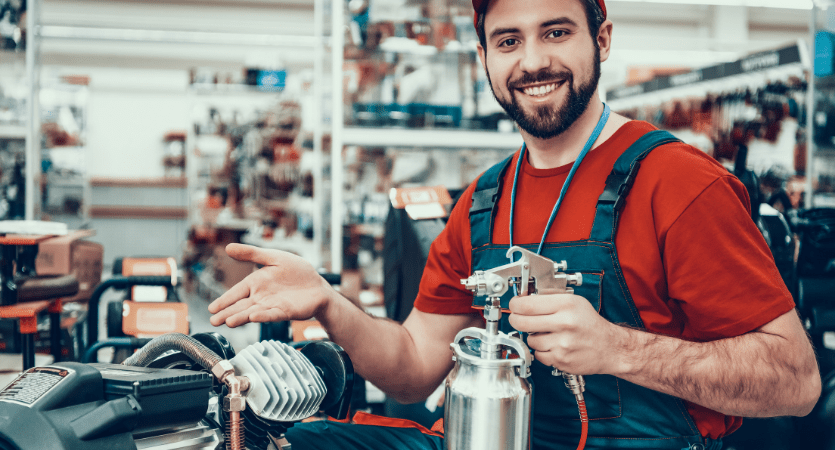If you are a DIY enthusiast, you must be looking for easier ways of doing things, whether at home or on your business premises. One of the things that will likely excite you is how to use a Wagner paint sprayer. There’s no better way of applying paint using a Wagner paint sprayer. It’s quite efficient and produces neat work.
All DIY enthusiasts or painting professionals will tell you that paint sprayers aren’t the same. They’ll also tell you that the Wagner paint sprayer is the best brand because its spray gun is more user-friendly and intuitive. To use a Wagner paint sprayer, you can follow the steps below.
Gather All the Materials You Need
Before applying paint, it’s better to have all the items you’ll need so you wouldn’t have to stop mid-way to search for the missing materials. To use a Wagner paint sprayer, you’ll need:
- Scrap cardboard
- Ladder (if the surface you want to paint is very high above the ground)
- Suitable clothing
- Paint respirators
- Goggles
- Gloves
- Two buckets
- Paint
- Spray gun
Apart from the above items, you’ll also need some pieces of paper (or any other suitable material) to cover the surfaces you don’t want the paint to reach. It’s advisable to clear the room of any movable pieces or objects such as furniture, so you won’t have so many things to cover. Any object that remains in the room should be moved to the middle of the room.
1. Prepare your paint
The greatest advantage of a Wagner paint sprayer is that it can be used with unthinned paint. Remember that different paint types can be used with sprayers, but you have to check and ensure the paint you’ve chosen is compatible with the sprayer.
Locate where the paint canister is, then transfer the paint into it. If the paint sprayer you have doesn’t have a paint canister, then it means a suction hose can be attached directly to the can.
2. Test the Wagner paint sprayer settings
You need to get the feel of the Wagner paint sprayer before you start using it on your wall. You can use scrap cardboard for this purpose. The sprayer has three important settings, including the spray pattern, spray tip, and pressure. You can adjust the pressure and spray tip then test the pattern it produces on the cardboard. Try different settings until you get the setting that produces the best spray.
Remember, the pressure level determines how fast the paint is discharged from the can. Very high pressure may cause overspray resulting in an uneven pattern. Very low pressure results in poor atomization, which, in turn, lowers the quality of the finish.
The choice of a spray tip depends on the viscosity of the paint you intend to use. If your paint has thicker viscosity, then you’ll need large spray tips. Small spray tips work well with less viscous paints. Also, test the perfect distance to hold your spray gun to produce the best result. A Wagner paint sprayer produces two spray patterns: horizontal and vertical.
3. Start spraying
Once you’ve determined the perfect setting and distance, you can now start spraying the paint on the wall. You can start spraying from one corner of the room and spray either horizontally or vertically. Make sure you practice a movement that you are most comfortable with so you can produce a stable spraying pattern. Make sure the pain thickness is uniform.
4. Adjust the sprayer setting for finishing
Once you are done spraying the whole room, you can now adjust the settings of the sprayer for finishing. This is the time you’ll have to address the edges and corners. Lower the pressure of the sprayer to help you have greater control so you can finish the work neatly.
5. Allow the paint to dry
After finishing, allow the paint to dry. The best thing about using a Wagner sprayer is that the paint it sprays dries very fast. Once the first layer dries, you can apply the next layer. As you wait for the last layer to dry, you can clean the sprayer, replace its tip, then also give it time to dry before storing it.
Frequently Asked Questions
Q: Is a Wagner Paint Sprayer really necessary?
Yes. If you want to work faster and efficiently, you’ll need a Wagner paint sprayer. This tool will also help you get a uniform layer while at the same time ensuring you don’t waste your paint.
Q: Is a Thin Paint needed for Wagner Sprayer?
You can use either thin or thick paint with your Wagner sprayer. It all depends on the type of sprayer and the spray tip you are using.
Q: Can Paint be left in the Wagner Sprayer Overnight?
Yes. However, many people prefer to drain the paint off to protect the spray gun. The paint left in the sprayer overnight can dry and cause other issues, even making it difficult to clean the sprayer later.
Q: Can a Primer be used in a Paint Sprayer?
Yes, you can use a primer in your Wagner sprayer, although you may require some thinning. Check your Wagner sprayer specs to confirm whether it can handle primer.
Conclusion
As you can see, a Wagner paint sprayer is a tool that’s very easy to use. It’s quite versatile. You can even prime it and even thin the more viscous paints if you use them with this tool. The tool is quite easy to operate and maintain. Make sure you follow the manufacturer’s instructions on what type of paint to use.

